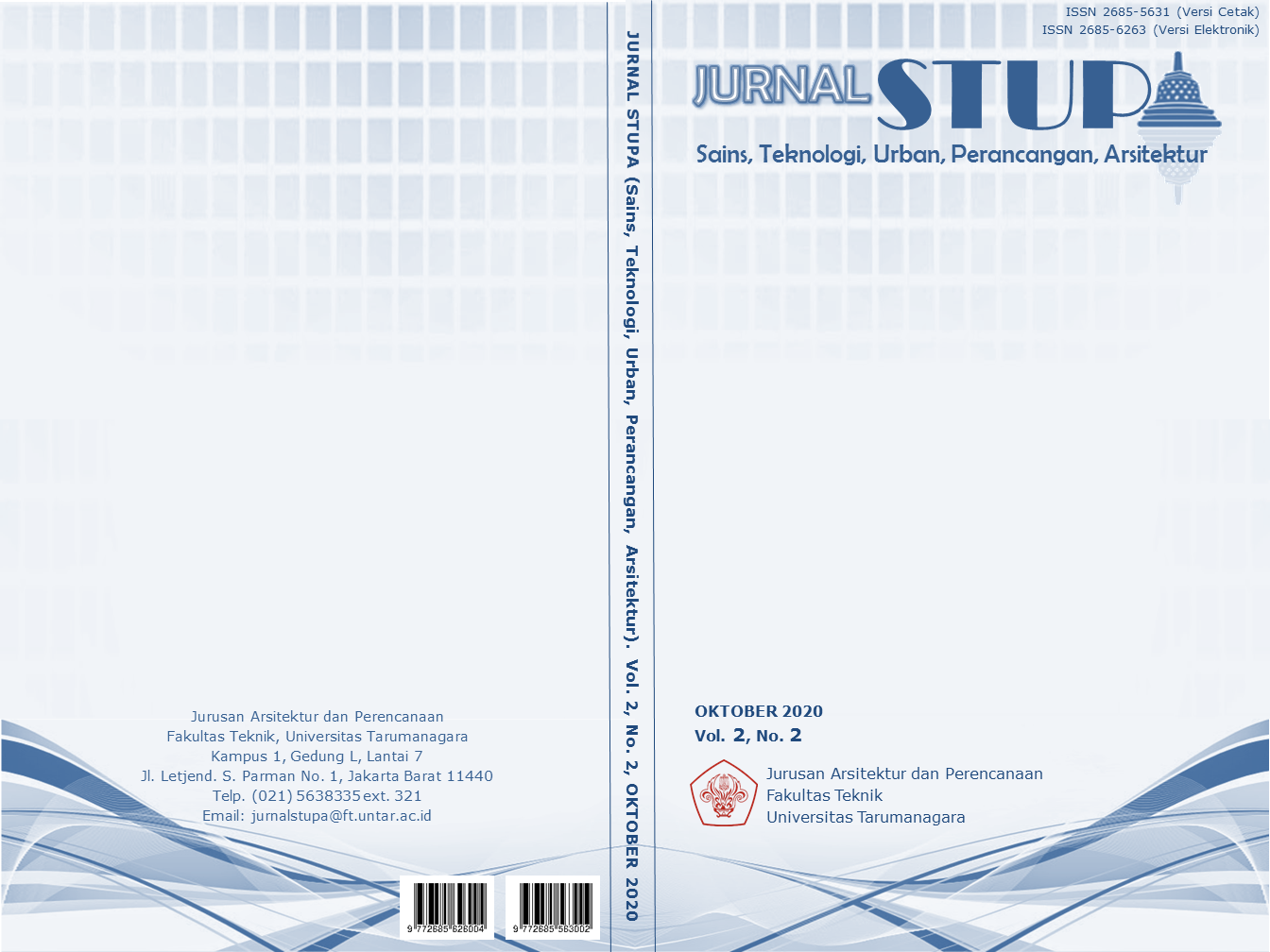DESAIN FASILITAS OLAHRAGA DAN REKREASI DENGAN PENDEKATAN KANONIS DI DURI KEPA, JAKARTA
Main Article Content
Abstract
The problem of population density has become a fairly common problem in big cities. The effects that can arise from population problems include the appearance of slums, the decline in environmental quality, and the impact on psychological conditions in the form of stress. One method that can solve the problem due to population density is the construction of supporting facilities. Housing can be adequate and improve its quality because of the availability of supporting facilities in a residential group. This is because supporting facilities can facilitate direct contact between individuals, where several individuals can communicate. The existence of public facilities can also facilitate recreational activities such as sports that can reduce the impact of stress. So it takes place for people who want to gather, treats stress, loneliness, and alienation, not only as a place to escape but also to relax, be entertained, and also get peace in it. The Sports and Recreation Facility at Duri Kepa is a project created so that the community, especially the Duri Kepa residents, have a place to relax, unwind, and be free to express themselves as manifested in sports and recreation activities. The design methodology used is canonical design, a design approach based on various aspects such as the geometrical aspects of objects, proportional systems, modules, and mass order, all of which lead to rule as the basis of design. This project seeks to meet the physical and social needs of the village community easily reached from the first place and second place. This project will be a place for community social interaction.
Keywords: Canonic Design; Recreation; Sport; Stress; Supporting Facilities
Abstrak
Masalah kepadatan penduduk sudah menjadi masalah yang cukup lazim di kota besar. Efek yang dapat ditimbulkan dari masalah kependudukan, antara lain munculnya kawasan kumuh, turunya kualitas lingkungan dan dampak terhadap kondisi psikologis berupa stress. Salah satu metode yang dapat memecahkan masalah akibat padatnya penduduk yaitu pembangunan fasilitas pendukung. Suatu perumahan dapat menjadi efektif dan meningkat kualitasnya karena ketersediaan fasilitas pendukung di suatu kelompok hunian. Hal ini dikarenakan fasilitas pendukung dapat memfasilitasi kontak langsung antar individual, dimana beberapa individual dapat melakukan komunikasi. Kemudian adanya fasilitas umum juga dapat memfasilitasi kegiatan rekreasional seperti olahraga yang dapat mengurangi dampak stress. Sehingga dibutuhkan suatu tempat bagi orang yang ingin berkumpul, mengobati stress,kesepian dan keterasingan, tidak hanya dijadikan tempat untuk melarikan diri, tetapi dimana orang akan bersantai, terhibur dan juga mendapatkan ketenangan didalamnya. Fasilitas Olahraga dan Rekreasi di Duri Kepa adalah sebuah proyek yang dibuat agar masyarakat khususnya warga Duri Kepa memiliki tempat untuk bersantai, melepas bosan, dan bebas untuk berekspresi di dalamnya yang diwujudkan dalam aktivitas berolahraga dan berekreasi. Metode desain yang digunakan adalah desain kanonis yaitu perancangan berdasarkan berbagai aspek tertentu seperti sistem proporsi, aspek geometrika objek, tatanan massa, modul yang mengarah kepada keteraturan. Proyek ini berusaha untuk memenuhi kebutuhan fisik maupun sosial masyarakat kelurahannya dengan mudah di jangkau dari first place maupun second place. Project ini akan menjadi tempat yang mewadahi interaksi sosial masyarakat.
Article Details
References
BroadBent, G. (1973), Design In Architecture. Architecture and the Human Sciences. London: John Wiley and Sons Inc.
Doling, J. (1976). The Family Life Cycle and Housing Choice. Urban Studies 13(1), 55-58. https://www.jstor.org/stable/43081368?seq=1
Hockings, M. & Axford, J. (2005). Sense of place: A tool to assist the meaningful engagement of communities in protected area management. International Conference on Engaging Communities, Brisbane, QLD, Australia, 14-17 August 2005. Brisbane, QLD, Australia: Queensland Department of Main Roads. Retrieved from https://espace.library.uq.edu.au/view/UQ:102844
Jorgensen, B. S. & Stedman, R. C. (2001). Sense of Place as an attitude: Lakeshore Owners Attitudes Toward Their Properties. Journal of Environmental Psychology 21(3), 233-248. DOI: 10.1006/jevp.2001.0226
Kaltenborn, B.P. & Williams, D. R. (2002). The meaning of place: attachments to Femundsmarka National Park, Norway, among tourists and locals. Norsk Geogra?sk Tidsskrift–Norwegian Journal of Geography 56, 189-198.
Oldenberg, R. (1999). The Great Good Place: Cafés, Coffee Shops, Bookstores, Bars, Hair Salons, and Other Hangouts at The Heart of A Community. Cambridge: Da Capro Press.
Perry, C. (1929). The neighborhood unit, a scheme of arrangement for the family-life comunity. Monograph 1 in vol.7 of Neighborhood and Community Planning. New York: Commite on Regional Plan of new Yorkand Its Environs.
Shamai, S. (1991). Sense of Place: An Empirical Measurement. Geoforum 22(3), 347-358. DOI: 10.1016/0016-7185(91)90017-K
Whrightsman and Deaux (1981). Social Psychology in the 80's. Monterey. California: Brools.



